Comprehensive Report: Law of Business Enterprises - Key Legal Concepts
VerifiedAdded on 2020/02/05
|8
|2588
|529
Report
AI Summary
This report provides a detailed analysis of the Law of Business Enterprises, covering the concept of incorporation, the principle of separate legal personality, and the implications of limited liability. It explores the formation of legal entities, the roles of directors and shareholders, and the legal distinctions between a company and its members. The report examines landmark cases like Salomon v A Salomon & Co Ltd and Lee v Lee's Air Farming Ltd to illustrate key principles. Additionally, it addresses the concept of piercing the corporate veil, outlining circumstances under which the limited liability of shareholders can be disregarded. The report concludes by summarizing the core legal aspects of business enterprises and their practical implications.
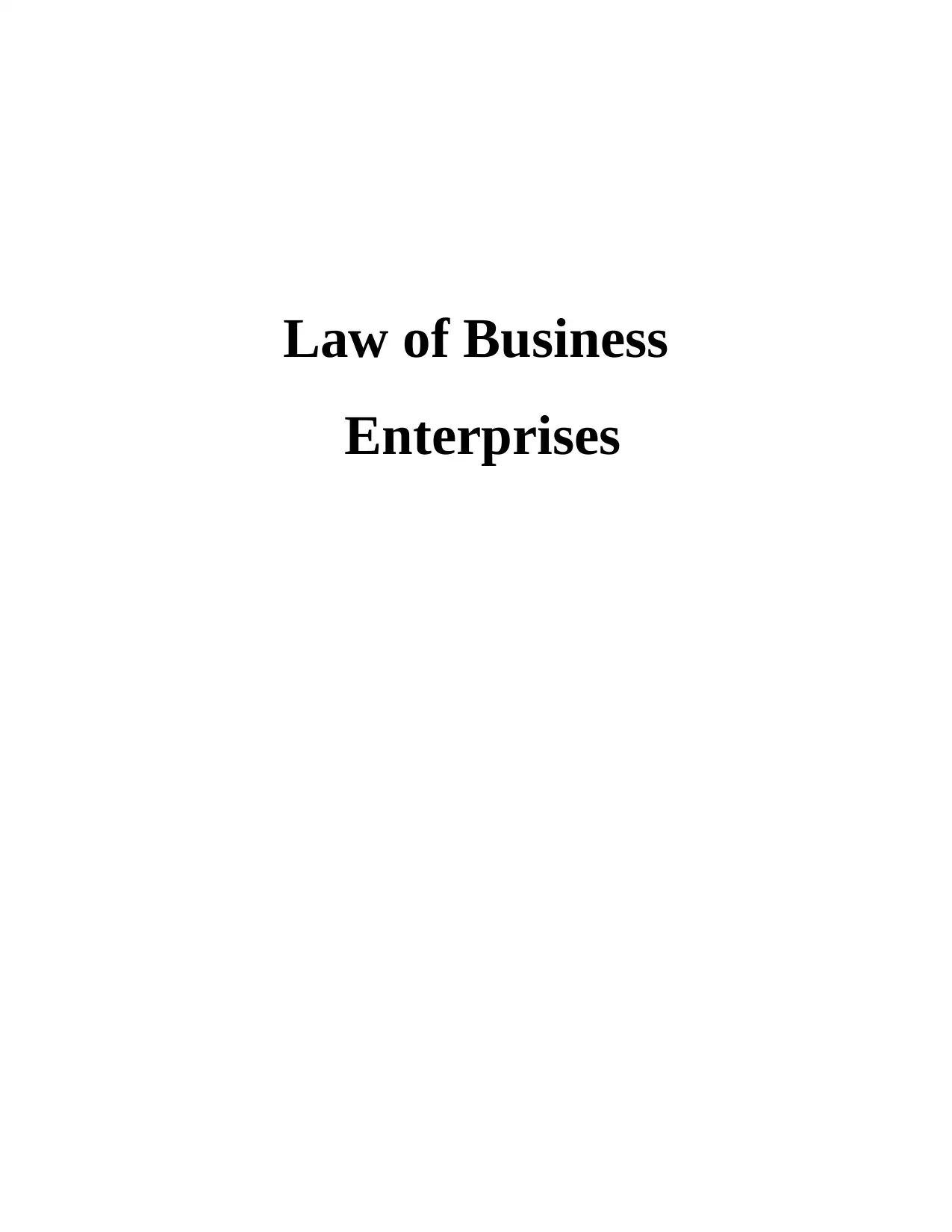
Law of Business
Enterprises
Enterprises
Paraphrase This Document
Need a fresh take? Get an instant paraphrase of this document with our AI Paraphraser
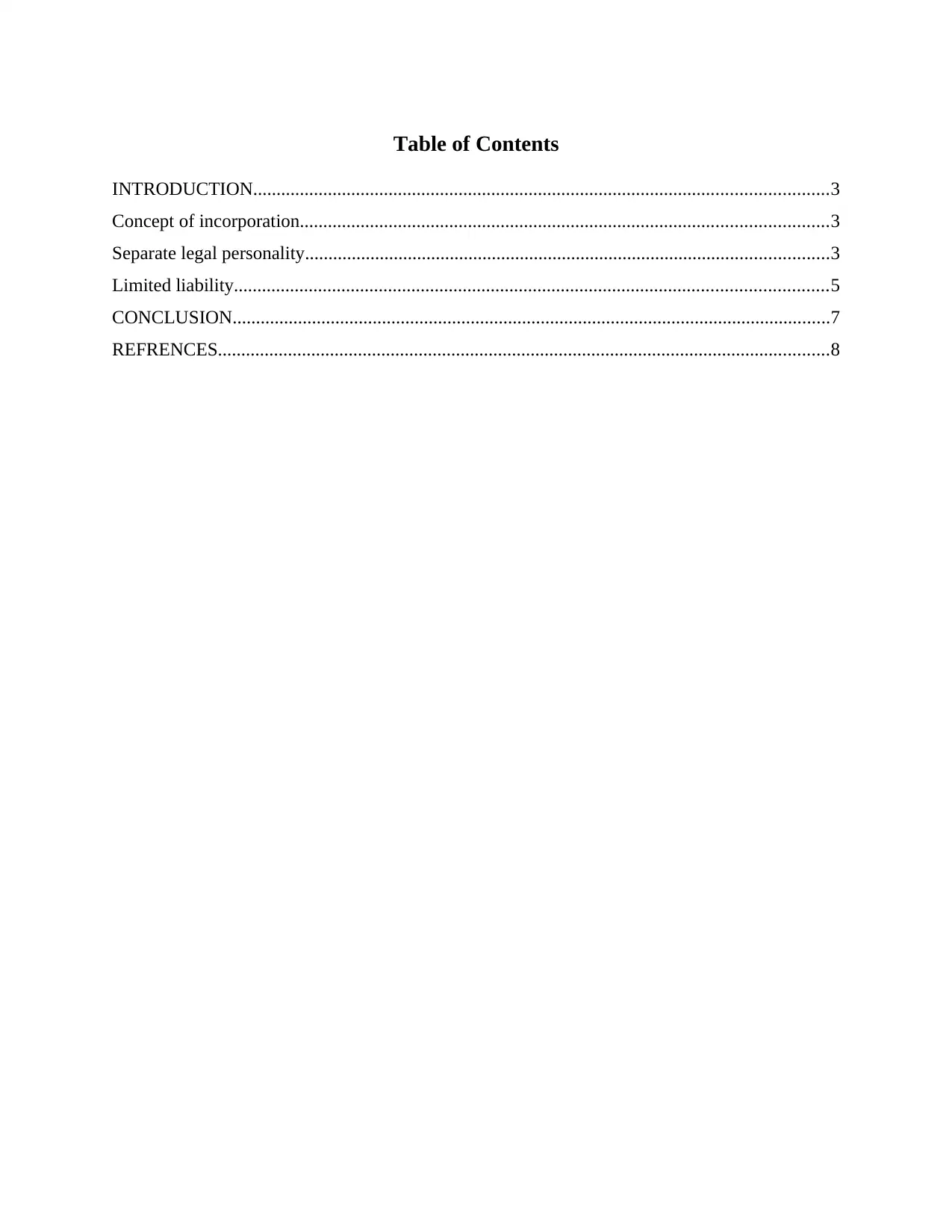
Table of Contents
INTRODUCTION...........................................................................................................................3
Concept of incorporation.................................................................................................................3
Separate legal personality................................................................................................................3
Limited liability...............................................................................................................................5
CONCLUSION................................................................................................................................7
REFRENCES...................................................................................................................................8
INTRODUCTION...........................................................................................................................3
Concept of incorporation.................................................................................................................3
Separate legal personality................................................................................................................3
Limited liability...............................................................................................................................5
CONCLUSION................................................................................................................................7
REFRENCES...................................................................................................................................8
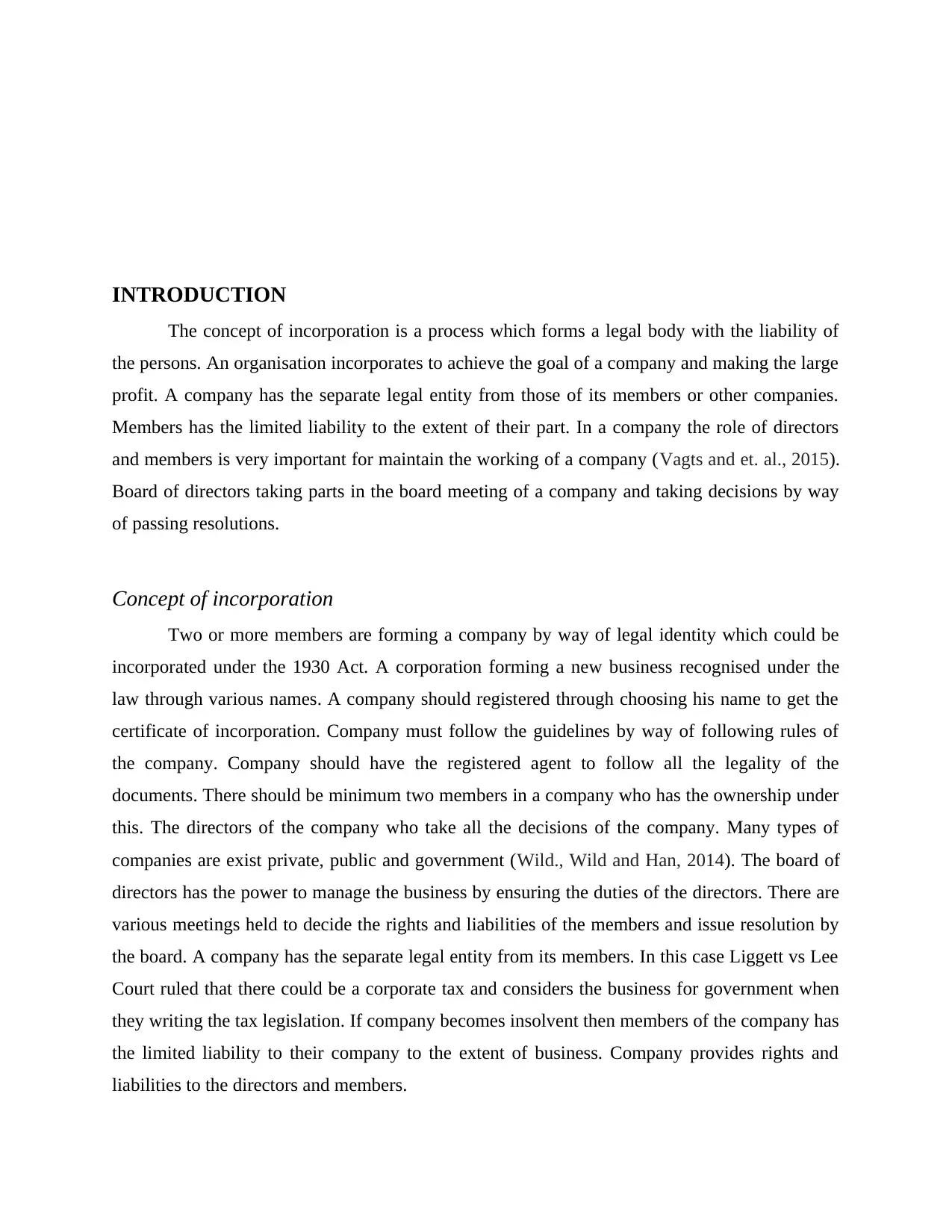
INTRODUCTION
The concept of incorporation is a process which forms a legal body with the liability of
the persons. An organisation incorporates to achieve the goal of a company and making the large
profit. A company has the separate legal entity from those of its members or other companies.
Members has the limited liability to the extent of their part. In a company the role of directors
and members is very important for maintain the working of a company (Vagts and et. al., 2015).
Board of directors taking parts in the board meeting of a company and taking decisions by way
of passing resolutions.
Concept of incorporation
Two or more members are forming a company by way of legal identity which could be
incorporated under the 1930 Act. A corporation forming a new business recognised under the
law through various names. A company should registered through choosing his name to get the
certificate of incorporation. Company must follow the guidelines by way of following rules of
the company. Company should have the registered agent to follow all the legality of the
documents. There should be minimum two members in a company who has the ownership under
this. The directors of the company who take all the decisions of the company. Many types of
companies are exist private, public and government (Wild., Wild and Han, 2014). The board of
directors has the power to manage the business by ensuring the duties of the directors. There are
various meetings held to decide the rights and liabilities of the members and issue resolution by
the board. A company has the separate legal entity from its members. In this case Liggett vs Lee
Court ruled that there could be a corporate tax and considers the business for government when
they writing the tax legislation. If company becomes insolvent then members of the company has
the limited liability to their company to the extent of business. Company provides rights and
liabilities to the directors and members.
The concept of incorporation is a process which forms a legal body with the liability of
the persons. An organisation incorporates to achieve the goal of a company and making the large
profit. A company has the separate legal entity from those of its members or other companies.
Members has the limited liability to the extent of their part. In a company the role of directors
and members is very important for maintain the working of a company (Vagts and et. al., 2015).
Board of directors taking parts in the board meeting of a company and taking decisions by way
of passing resolutions.
Concept of incorporation
Two or more members are forming a company by way of legal identity which could be
incorporated under the 1930 Act. A corporation forming a new business recognised under the
law through various names. A company should registered through choosing his name to get the
certificate of incorporation. Company must follow the guidelines by way of following rules of
the company. Company should have the registered agent to follow all the legality of the
documents. There should be minimum two members in a company who has the ownership under
this. The directors of the company who take all the decisions of the company. Many types of
companies are exist private, public and government (Wild., Wild and Han, 2014). The board of
directors has the power to manage the business by ensuring the duties of the directors. There are
various meetings held to decide the rights and liabilities of the members and issue resolution by
the board. A company has the separate legal entity from its members. In this case Liggett vs Lee
Court ruled that there could be a corporate tax and considers the business for government when
they writing the tax legislation. If company becomes insolvent then members of the company has
the limited liability to their company to the extent of business. Company provides rights and
liabilities to the directors and members.
⊘ This is a preview!⊘
Do you want full access?
Subscribe today to unlock all pages.

Trusted by 1+ million students worldwide
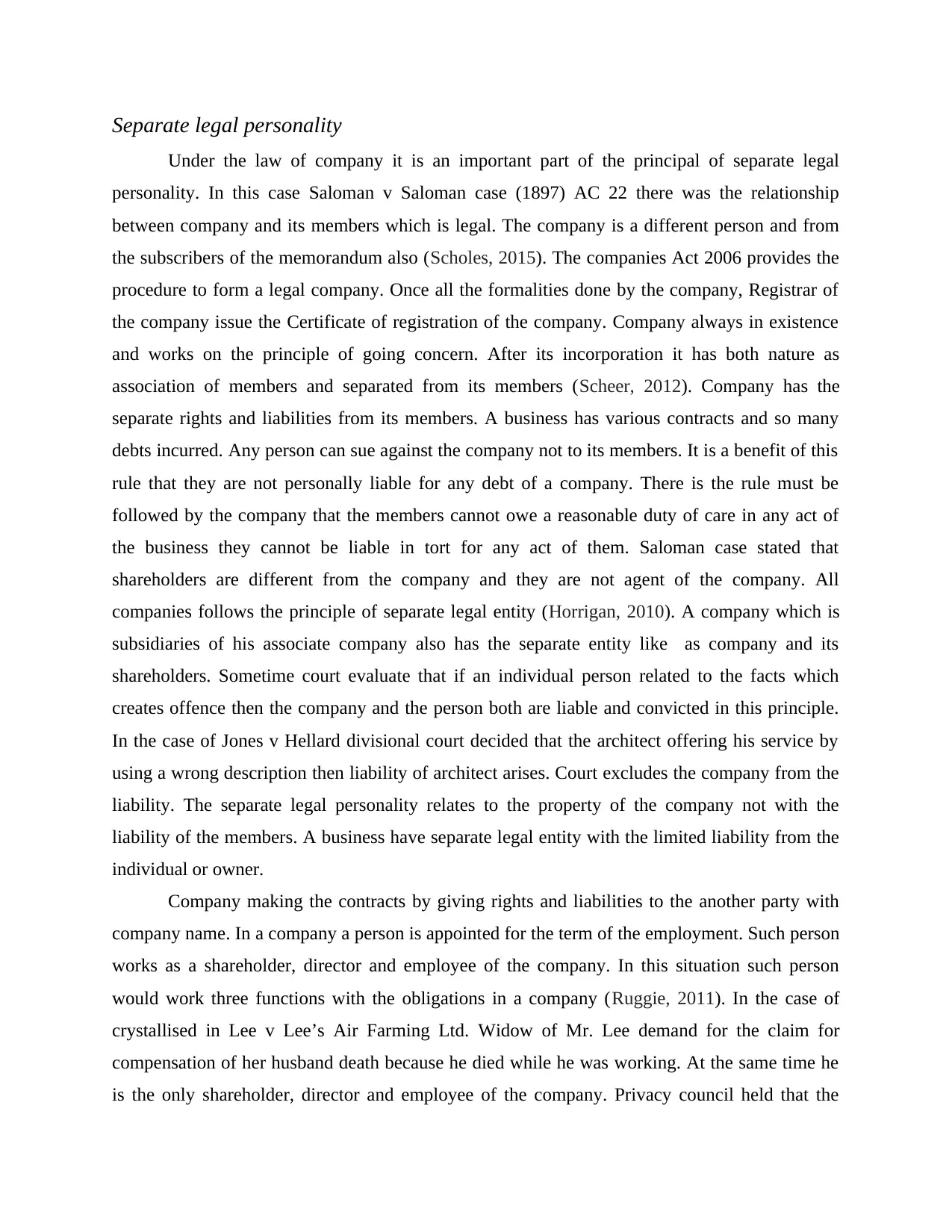
Separate legal personality
Under the law of company it is an important part of the principal of separate legal
personality. In this case Saloman v Saloman case (1897) AC 22 there was the relationship
between company and its members which is legal. The company is a different person and from
the subscribers of the memorandum also (Scholes, 2015). The companies Act 2006 provides the
procedure to form a legal company. Once all the formalities done by the company, Registrar of
the company issue the Certificate of registration of the company. Company always in existence
and works on the principle of going concern. After its incorporation it has both nature as
association of members and separated from its members (Scheer, 2012). Company has the
separate rights and liabilities from its members. A business has various contracts and so many
debts incurred. Any person can sue against the company not to its members. It is a benefit of this
rule that they are not personally liable for any debt of a company. There is the rule must be
followed by the company that the members cannot owe a reasonable duty of care in any act of
the business they cannot be liable in tort for any act of them. Saloman case stated that
shareholders are different from the company and they are not agent of the company. All
companies follows the principle of separate legal entity (Horrigan, 2010). A company which is
subsidiaries of his associate company also has the separate entity like as company and its
shareholders. Sometime court evaluate that if an individual person related to the facts which
creates offence then the company and the person both are liable and convicted in this principle.
In the case of Jones v Hellard divisional court decided that the architect offering his service by
using a wrong description then liability of architect arises. Court excludes the company from the
liability. The separate legal personality relates to the property of the company not with the
liability of the members. A business have separate legal entity with the limited liability from the
individual or owner.
Company making the contracts by giving rights and liabilities to the another party with
company name. In a company a person is appointed for the term of the employment. Such person
works as a shareholder, director and employee of the company. In this situation such person
would work three functions with the obligations in a company (Ruggie, 2011). In the case of
crystallised in Lee v Lee’s Air Farming Ltd. Widow of Mr. Lee demand for the claim for
compensation of her husband death because he died while he was working. At the same time he
is the only shareholder, director and employee of the company. Privacy council held that the
Under the law of company it is an important part of the principal of separate legal
personality. In this case Saloman v Saloman case (1897) AC 22 there was the relationship
between company and its members which is legal. The company is a different person and from
the subscribers of the memorandum also (Scholes, 2015). The companies Act 2006 provides the
procedure to form a legal company. Once all the formalities done by the company, Registrar of
the company issue the Certificate of registration of the company. Company always in existence
and works on the principle of going concern. After its incorporation it has both nature as
association of members and separated from its members (Scheer, 2012). Company has the
separate rights and liabilities from its members. A business has various contracts and so many
debts incurred. Any person can sue against the company not to its members. It is a benefit of this
rule that they are not personally liable for any debt of a company. There is the rule must be
followed by the company that the members cannot owe a reasonable duty of care in any act of
the business they cannot be liable in tort for any act of them. Saloman case stated that
shareholders are different from the company and they are not agent of the company. All
companies follows the principle of separate legal entity (Horrigan, 2010). A company which is
subsidiaries of his associate company also has the separate entity like as company and its
shareholders. Sometime court evaluate that if an individual person related to the facts which
creates offence then the company and the person both are liable and convicted in this principle.
In the case of Jones v Hellard divisional court decided that the architect offering his service by
using a wrong description then liability of architect arises. Court excludes the company from the
liability. The separate legal personality relates to the property of the company not with the
liability of the members. A business have separate legal entity with the limited liability from the
individual or owner.
Company making the contracts by giving rights and liabilities to the another party with
company name. In a company a person is appointed for the term of the employment. Such person
works as a shareholder, director and employee of the company. In this situation such person
would work three functions with the obligations in a company (Ruggie, 2011). In the case of
crystallised in Lee v Lee’s Air Farming Ltd. Widow of Mr. Lee demand for the claim for
compensation of her husband death because he died while he was working. At the same time he
is the only shareholder, director and employee of the company. Privacy council held that the
Paraphrase This Document
Need a fresh take? Get an instant paraphrase of this document with our AI Paraphraser
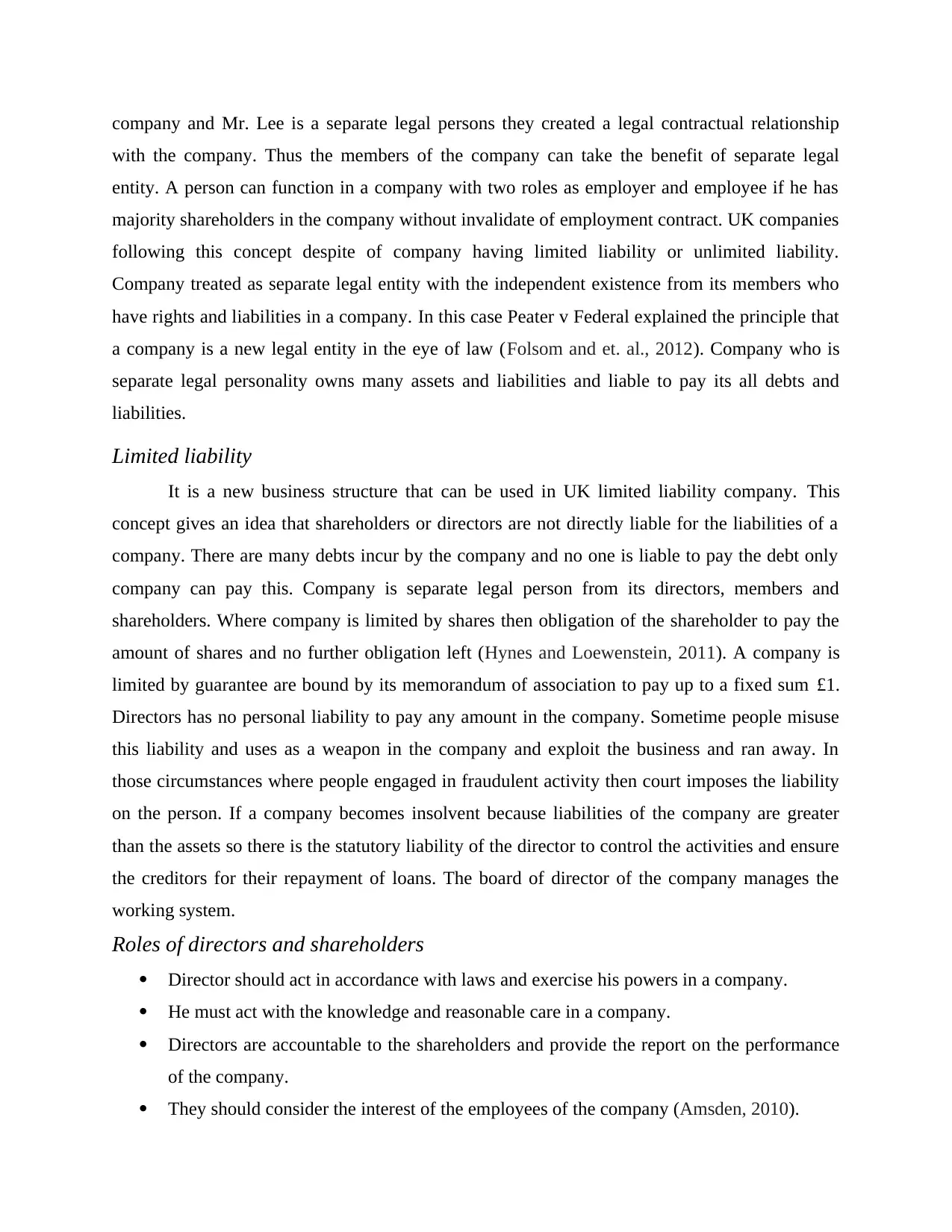
company and Mr. Lee is a separate legal persons they created a legal contractual relationship
with the company. Thus the members of the company can take the benefit of separate legal
entity. A person can function in a company with two roles as employer and employee if he has
majority shareholders in the company without invalidate of employment contract. UK companies
following this concept despite of company having limited liability or unlimited liability.
Company treated as separate legal entity with the independent existence from its members who
have rights and liabilities in a company. In this case Peater v Federal explained the principle that
a company is a new legal entity in the eye of law (Folsom and et. al., 2012). Company who is
separate legal personality owns many assets and liabilities and liable to pay its all debts and
liabilities.
Limited liability
It is a new business structure that can be used in UK limited liability company. This
concept gives an idea that shareholders or directors are not directly liable for the liabilities of a
company. There are many debts incur by the company and no one is liable to pay the debt only
company can pay this. Company is separate legal person from its directors, members and
shareholders. Where company is limited by shares then obligation of the shareholder to pay the
amount of shares and no further obligation left (Hynes and Loewenstein, 2011). A company is
limited by guarantee are bound by its memorandum of association to pay up to a fixed sum £1.
Directors has no personal liability to pay any amount in the company. Sometime people misuse
this liability and uses as a weapon in the company and exploit the business and ran away. In
those circumstances where people engaged in fraudulent activity then court imposes the liability
on the person. If a company becomes insolvent because liabilities of the company are greater
than the assets so there is the statutory liability of the director to control the activities and ensure
the creditors for their repayment of loans. The board of director of the company manages the
working system.
Roles of directors and shareholders
Director should act in accordance with laws and exercise his powers in a company.
He must act with the knowledge and reasonable care in a company.
Directors are accountable to the shareholders and provide the report on the performance
of the company.
They should consider the interest of the employees of the company (Amsden, 2010).
with the company. Thus the members of the company can take the benefit of separate legal
entity. A person can function in a company with two roles as employer and employee if he has
majority shareholders in the company without invalidate of employment contract. UK companies
following this concept despite of company having limited liability or unlimited liability.
Company treated as separate legal entity with the independent existence from its members who
have rights and liabilities in a company. In this case Peater v Federal explained the principle that
a company is a new legal entity in the eye of law (Folsom and et. al., 2012). Company who is
separate legal personality owns many assets and liabilities and liable to pay its all debts and
liabilities.
Limited liability
It is a new business structure that can be used in UK limited liability company. This
concept gives an idea that shareholders or directors are not directly liable for the liabilities of a
company. There are many debts incur by the company and no one is liable to pay the debt only
company can pay this. Company is separate legal person from its directors, members and
shareholders. Where company is limited by shares then obligation of the shareholder to pay the
amount of shares and no further obligation left (Hynes and Loewenstein, 2011). A company is
limited by guarantee are bound by its memorandum of association to pay up to a fixed sum £1.
Directors has no personal liability to pay any amount in the company. Sometime people misuse
this liability and uses as a weapon in the company and exploit the business and ran away. In
those circumstances where people engaged in fraudulent activity then court imposes the liability
on the person. If a company becomes insolvent because liabilities of the company are greater
than the assets so there is the statutory liability of the director to control the activities and ensure
the creditors for their repayment of loans. The board of director of the company manages the
working system.
Roles of directors and shareholders
Director should act in accordance with laws and exercise his powers in a company.
He must act with the knowledge and reasonable care in a company.
Directors are accountable to the shareholders and provide the report on the performance
of the company.
They should consider the interest of the employees of the company (Amsden, 2010).
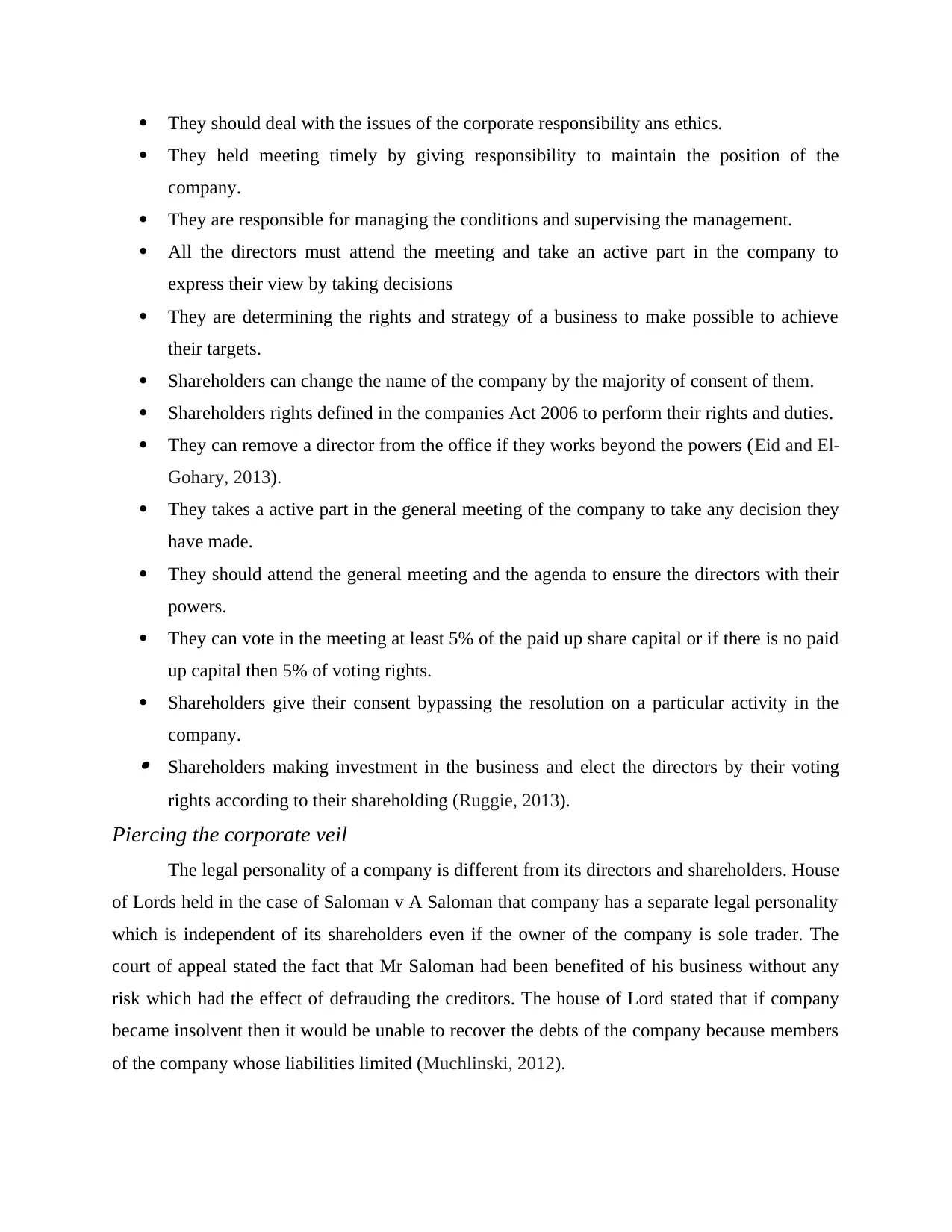
They should deal with the issues of the corporate responsibility ans ethics.
They held meeting timely by giving responsibility to maintain the position of the
company.
They are responsible for managing the conditions and supervising the management.
All the directors must attend the meeting and take an active part in the company to
express their view by taking decisions
They are determining the rights and strategy of a business to make possible to achieve
their targets.
Shareholders can change the name of the company by the majority of consent of them.
Shareholders rights defined in the companies Act 2006 to perform their rights and duties.
They can remove a director from the office if they works beyond the powers (Eid and El-
Gohary, 2013).
They takes a active part in the general meeting of the company to take any decision they
have made.
They should attend the general meeting and the agenda to ensure the directors with their
powers.
They can vote in the meeting at least 5% of the paid up share capital or if there is no paid
up capital then 5% of voting rights.
Shareholders give their consent bypassing the resolution on a particular activity in the
company. Shareholders making investment in the business and elect the directors by their voting
rights according to their shareholding (Ruggie, 2013).
Piercing the corporate veil
The legal personality of a company is different from its directors and shareholders. House
of Lords held in the case of Saloman v A Saloman that company has a separate legal personality
which is independent of its shareholders even if the owner of the company is sole trader. The
court of appeal stated the fact that Mr Saloman had been benefited of his business without any
risk which had the effect of defrauding the creditors. The house of Lord stated that if company
became insolvent then it would be unable to recover the debts of the company because members
of the company whose liabilities limited (Muchlinski, 2012).
They held meeting timely by giving responsibility to maintain the position of the
company.
They are responsible for managing the conditions and supervising the management.
All the directors must attend the meeting and take an active part in the company to
express their view by taking decisions
They are determining the rights and strategy of a business to make possible to achieve
their targets.
Shareholders can change the name of the company by the majority of consent of them.
Shareholders rights defined in the companies Act 2006 to perform their rights and duties.
They can remove a director from the office if they works beyond the powers (Eid and El-
Gohary, 2013).
They takes a active part in the general meeting of the company to take any decision they
have made.
They should attend the general meeting and the agenda to ensure the directors with their
powers.
They can vote in the meeting at least 5% of the paid up share capital or if there is no paid
up capital then 5% of voting rights.
Shareholders give their consent bypassing the resolution on a particular activity in the
company. Shareholders making investment in the business and elect the directors by their voting
rights according to their shareholding (Ruggie, 2013).
Piercing the corporate veil
The legal personality of a company is different from its directors and shareholders. House
of Lords held in the case of Saloman v A Saloman that company has a separate legal personality
which is independent of its shareholders even if the owner of the company is sole trader. The
court of appeal stated the fact that Mr Saloman had been benefited of his business without any
risk which had the effect of defrauding the creditors. The house of Lord stated that if company
became insolvent then it would be unable to recover the debts of the company because members
of the company whose liabilities limited (Muchlinski, 2012).
⊘ This is a preview!⊘
Do you want full access?
Subscribe today to unlock all pages.

Trusted by 1+ million students worldwide
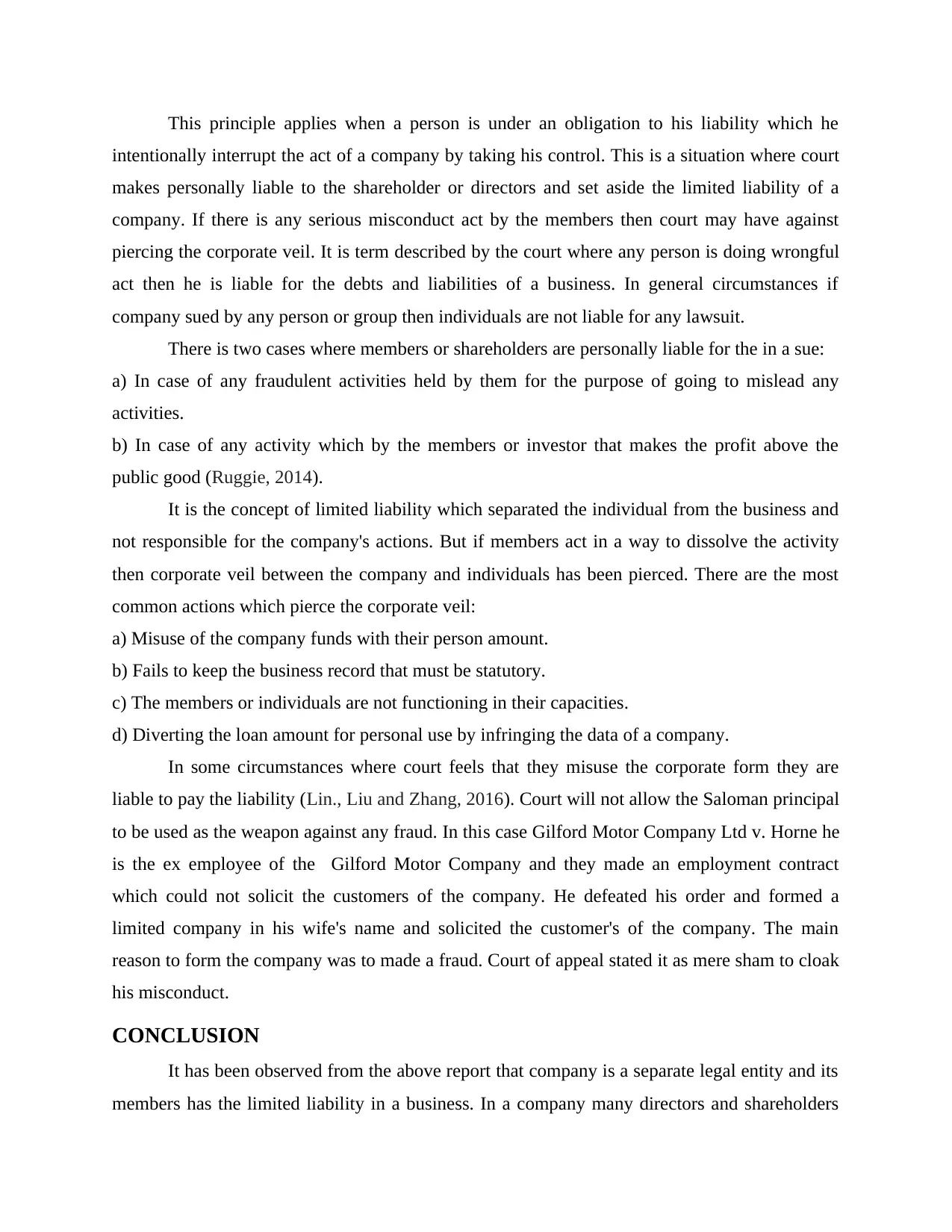
This principle applies when a person is under an obligation to his liability which he
intentionally interrupt the act of a company by taking his control. This is a situation where court
makes personally liable to the shareholder or directors and set aside the limited liability of a
company. If there is any serious misconduct act by the members then court may have against
piercing the corporate veil. It is term described by the court where any person is doing wrongful
act then he is liable for the debts and liabilities of a business. In general circumstances if
company sued by any person or group then individuals are not liable for any lawsuit.
There is two cases where members or shareholders are personally liable for the in a sue:
a) In case of any fraudulent activities held by them for the purpose of going to mislead any
activities.
b) In case of any activity which by the members or investor that makes the profit above the
public good (Ruggie, 2014).
It is the concept of limited liability which separated the individual from the business and
not responsible for the company's actions. But if members act in a way to dissolve the activity
then corporate veil between the company and individuals has been pierced. There are the most
common actions which pierce the corporate veil:
a) Misuse of the company funds with their person amount.
b) Fails to keep the business record that must be statutory.
c) The members or individuals are not functioning in their capacities.
d) Diverting the loan amount for personal use by infringing the data of a company.
In some circumstances where court feels that they misuse the corporate form they are
liable to pay the liability (Lin., Liu and Zhang, 2016). Court will not allow the Saloman principal
to be used as the weapon against any fraud. In this case Gilford Motor Company Ltd v. Horne he
is the ex employee of the Gilford Motor Company and they made an employment contract
which could not solicit the customers of the company. He defeated his order and formed a
limited company in his wife's name and solicited the customer's of the company. The main
reason to form the company was to made a fraud. Court of appeal stated it as mere sham to cloak
his misconduct.
CONCLUSION
It has been observed from the above report that company is a separate legal entity and its
members has the limited liability in a business. In a company many directors and shareholders
intentionally interrupt the act of a company by taking his control. This is a situation where court
makes personally liable to the shareholder or directors and set aside the limited liability of a
company. If there is any serious misconduct act by the members then court may have against
piercing the corporate veil. It is term described by the court where any person is doing wrongful
act then he is liable for the debts and liabilities of a business. In general circumstances if
company sued by any person or group then individuals are not liable for any lawsuit.
There is two cases where members or shareholders are personally liable for the in a sue:
a) In case of any fraudulent activities held by them for the purpose of going to mislead any
activities.
b) In case of any activity which by the members or investor that makes the profit above the
public good (Ruggie, 2014).
It is the concept of limited liability which separated the individual from the business and
not responsible for the company's actions. But if members act in a way to dissolve the activity
then corporate veil between the company and individuals has been pierced. There are the most
common actions which pierce the corporate veil:
a) Misuse of the company funds with their person amount.
b) Fails to keep the business record that must be statutory.
c) The members or individuals are not functioning in their capacities.
d) Diverting the loan amount for personal use by infringing the data of a company.
In some circumstances where court feels that they misuse the corporate form they are
liable to pay the liability (Lin., Liu and Zhang, 2016). Court will not allow the Saloman principal
to be used as the weapon against any fraud. In this case Gilford Motor Company Ltd v. Horne he
is the ex employee of the Gilford Motor Company and they made an employment contract
which could not solicit the customers of the company. He defeated his order and formed a
limited company in his wife's name and solicited the customer's of the company. The main
reason to form the company was to made a fraud. Court of appeal stated it as mere sham to cloak
his misconduct.
CONCLUSION
It has been observed from the above report that company is a separate legal entity and its
members has the limited liability in a business. In a company many directors and shareholders
Paraphrase This Document
Need a fresh take? Get an instant paraphrase of this document with our AI Paraphraser
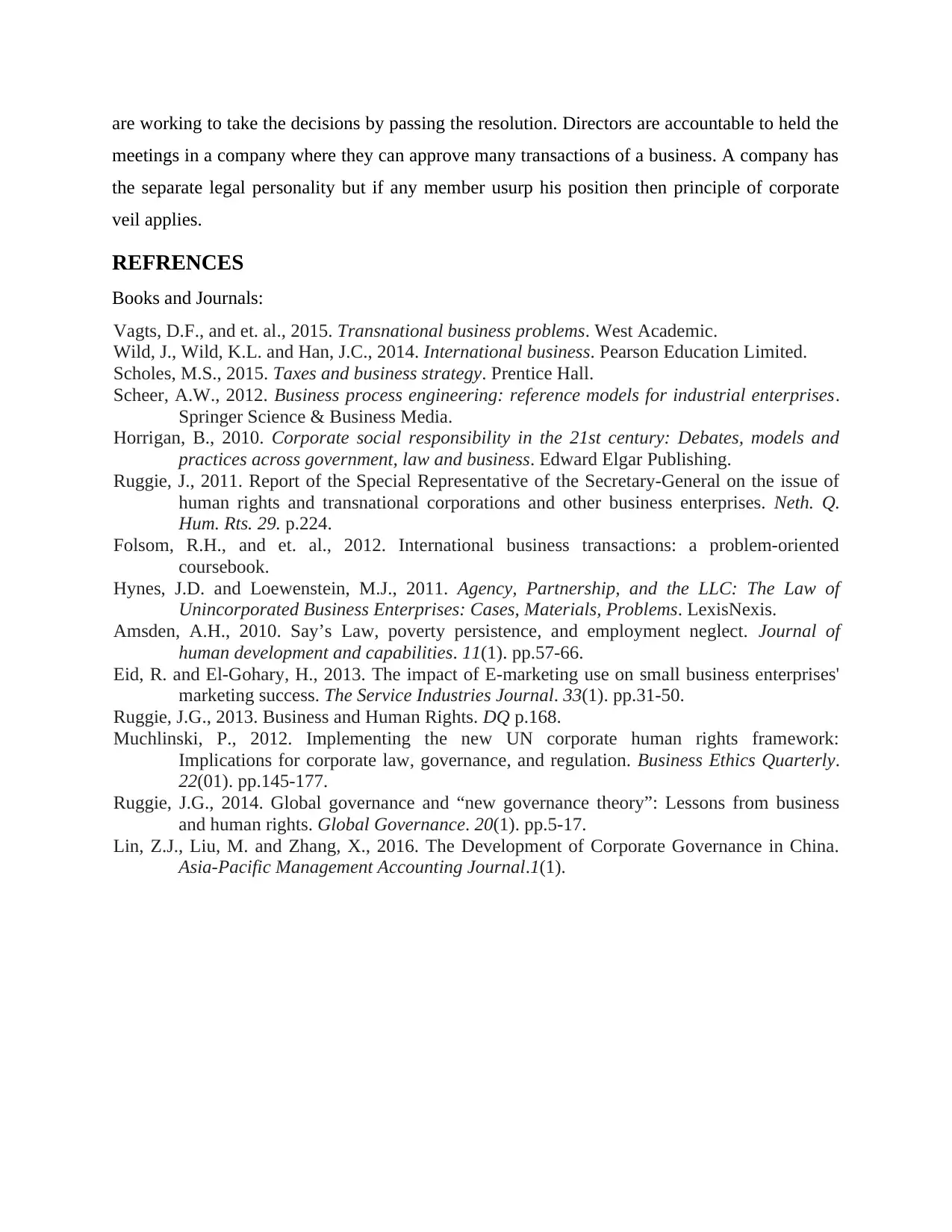
are working to take the decisions by passing the resolution. Directors are accountable to held the
meetings in a company where they can approve many transactions of a business. A company has
the separate legal personality but if any member usurp his position then principle of corporate
veil applies.
REFRENCES
Books and Journals:
Vagts, D.F., and et. al., 2015. Transnational business problems. West Academic.
Wild, J., Wild, K.L. and Han, J.C., 2014. International business. Pearson Education Limited.
Scholes, M.S., 2015. Taxes and business strategy. Prentice Hall.
Scheer, A.W., 2012. Business process engineering: reference models for industrial enterprises.
Springer Science & Business Media.
Horrigan, B., 2010. Corporate social responsibility in the 21st century: Debates, models and
practices across government, law and business. Edward Elgar Publishing.
Ruggie, J., 2011. Report of the Special Representative of the Secretary-General on the issue of
human rights and transnational corporations and other business enterprises. Neth. Q.
Hum. Rts. 29. p.224.
Folsom, R.H., and et. al., 2012. International business transactions: a problem-oriented
coursebook.
Hynes, J.D. and Loewenstein, M.J., 2011. Agency, Partnership, and the LLC: The Law of
Unincorporated Business Enterprises: Cases, Materials, Problems. LexisNexis.
Amsden, A.H., 2010. Say’s Law, poverty persistence, and employment neglect. Journal of
human development and capabilities. 11(1). pp.57-66.
Eid, R. and El-Gohary, H., 2013. The impact of E-marketing use on small business enterprises'
marketing success. The Service Industries Journal. 33(1). pp.31-50.
Ruggie, J.G., 2013. Business and Human Rights. DQ p.168.
Muchlinski, P., 2012. Implementing the new UN corporate human rights framework:
Implications for corporate law, governance, and regulation. Business Ethics Quarterly.
22(01). pp.145-177.
Ruggie, J.G., 2014. Global governance and “new governance theory”: Lessons from business
and human rights. Global Governance. 20(1). pp.5-17.
Lin, Z.J., Liu, M. and Zhang, X., 2016. The Development of Corporate Governance in China.
Asia-Pacific Management Accounting Journal.1(1).
meetings in a company where they can approve many transactions of a business. A company has
the separate legal personality but if any member usurp his position then principle of corporate
veil applies.
REFRENCES
Books and Journals:
Vagts, D.F., and et. al., 2015. Transnational business problems. West Academic.
Wild, J., Wild, K.L. and Han, J.C., 2014. International business. Pearson Education Limited.
Scholes, M.S., 2015. Taxes and business strategy. Prentice Hall.
Scheer, A.W., 2012. Business process engineering: reference models for industrial enterprises.
Springer Science & Business Media.
Horrigan, B., 2010. Corporate social responsibility in the 21st century: Debates, models and
practices across government, law and business. Edward Elgar Publishing.
Ruggie, J., 2011. Report of the Special Representative of the Secretary-General on the issue of
human rights and transnational corporations and other business enterprises. Neth. Q.
Hum. Rts. 29. p.224.
Folsom, R.H., and et. al., 2012. International business transactions: a problem-oriented
coursebook.
Hynes, J.D. and Loewenstein, M.J., 2011. Agency, Partnership, and the LLC: The Law of
Unincorporated Business Enterprises: Cases, Materials, Problems. LexisNexis.
Amsden, A.H., 2010. Say’s Law, poverty persistence, and employment neglect. Journal of
human development and capabilities. 11(1). pp.57-66.
Eid, R. and El-Gohary, H., 2013. The impact of E-marketing use on small business enterprises'
marketing success. The Service Industries Journal. 33(1). pp.31-50.
Ruggie, J.G., 2013. Business and Human Rights. DQ p.168.
Muchlinski, P., 2012. Implementing the new UN corporate human rights framework:
Implications for corporate law, governance, and regulation. Business Ethics Quarterly.
22(01). pp.145-177.
Ruggie, J.G., 2014. Global governance and “new governance theory”: Lessons from business
and human rights. Global Governance. 20(1). pp.5-17.
Lin, Z.J., Liu, M. and Zhang, X., 2016. The Development of Corporate Governance in China.
Asia-Pacific Management Accounting Journal.1(1).
1 out of 8
Related Documents
Your All-in-One AI-Powered Toolkit for Academic Success.
+13062052269
info@desklib.com
Available 24*7 on WhatsApp / Email
![[object Object]](/_next/static/media/star-bottom.7253800d.svg)
Unlock your academic potential
Copyright © 2020–2025 A2Z Services. All Rights Reserved. Developed and managed by ZUCOL.





